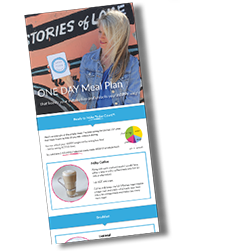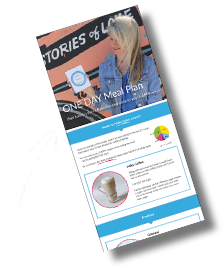
- For the 10 years I was overweight I drank skim milk
- Find out why low-fat dairy products keep you feeling hungry
- Whole milk has many other surprising health benefits
Are you drinking skim milk, 1% milk, 2% milk or whole milk?

You might be surprised to learn that whole milk helps you lose weight. I was! For the 10 years I struggled to lose weight I only drank skim milk. When I went back to drinking 2% milk, along with making other healthy choices, I unlocked my H 🙂 PPY weight.
You can too!
Recently I read about the benefits of drinking higher-fat milk. To my surprise, whole milk (3.25%) is actually the healthiest choice. If you’re new to this blog keep in mind: The healthiest choice helps you lose weight.
Now I’ve been drinking whole milk for almost 4 months and I love it! But I didn’t feel that way at first. I was actually put off by the idea. For some reason I thought whole milk was for people who are trying to gain weight–like kids going through a growth spurt or someone recovering from an illness. I think this false impression stemmed from all the weight-loss advertisements that push low-fat and no-fat food. We’re conditioned to fear fat! But now I know eating fat doesn’t make you fat. Eating fat from a natural source is part of a balanced meal. And eating balanced meals are part of reaching and maintaining a healthy weight.

Ok… let’s get to the facts.
Why whole milk helps you lose weight
Whole milk helps you lose weight because it’s the healthiest choice. And whole milk is the healthiest choice because it’s the most natural option.
…whole milk is the way it comes from the cow before processing.
-Dairy Council of California
 Remember, the more a food is processed, the more unnatural it is and therefore, the more it confuses your body. Whole milk is less processed than skim, 1% and 2% milk. In other words, milk that has 3.25% fat maintains more natural and healthy nutrients and has fewer ingredients added.
Remember, the more a food is processed, the more unnatural it is and therefore, the more it confuses your body. Whole milk is less processed than skim, 1% and 2% milk. In other words, milk that has 3.25% fat maintains more natural and healthy nutrients and has fewer ingredients added.
Skim milk, for example, is the product that’s left over after the cream is removed. But the cream is packed with essential nutrients, including fat-soluble vitamins A, D, E and K. These vitamins are key. Once consumed, they send a signal to your brain. Then you feel full. Why? Because your body has what it needs to do its important jobs.
The beauty of whole foods
Eating whole foods–especially eating balanced meals and snacks made of whole foods, prevents you from overeating. This combination of natural food contains the energy and nutrients your body needs. Then you feel satisfied.
 But skim milk is void of these vitamins. That’s why you can eat tons of low-fat dairy products–like low-fat yogurt, low-fat cheese and low-fat sour cream, and still feel hungry; your body will keep sending hunger signals until it has all the nourishment it requires.
But skim milk is void of these vitamins. That’s why you can eat tons of low-fat dairy products–like low-fat yogurt, low-fat cheese and low-fat sour cream, and still feel hungry; your body will keep sending hunger signals until it has all the nourishment it requires.
Put simply, the processing skim milk goes through is similar to white flour. White flour has the bran and germ removed; the most nutritious parts of the grain. The bran and germ contain B vitamins, antioxidants, fiber, protein, minerals and healthy fat. Not only do all these nutrients take time to break down (so energy is released slowly and you stay full longer) but your body also needs all these nutrients to function properly. And when your body functions properly, (drum roll!) it’s easier to reach and maintain a healthy weight.
Eating whole foods fills you up naturally. Then you lose weight naturally.

Michael Pollan says it best:
To make dairy products low fat, it’s not enough to remove the fat. You then have to go to great lengths to preserve the body or creamy texture by working in all kinds of food additives. In the case of low-fat or skim milk, that usually means adding powdered milk. But powdered milk contains oxidized cholesterol, which scientists believe is much worse for your arteries than ordinary cholesterol, so food makers sometimes compensate by adding antioxidants, further complicating what had been a simple one-ingredient whole food. Also, removing the fat makes it that much harder for your body to absorb the fat-soluble vitamins that are one of the reasons to drink milk in the first place.
-From: In Defense of Food: An Eater’s Manifesto
Research proves whole milk helps you lose weight
Still not convinced that whole milk helps you lose weight?! Tons of studies found that men and women who eat full-fat dairy are less likely to be obese. In fact, more and more research is showing that cutting out foods that are naturally high in fat, like red meat, butter, dairy and eggs, and choosing low-fat alternatives like skim milk, not only lead to weight gain but have caused the rate of chronic disease to skyrocket.
More evidence that whole milk helps you lose weight
As much as I love scientific research, a personal story is always powerful.
Since we started drinking whole milk 3 years ago, my husband and I have each had a huge reduction in cholesterol. 30 points each to be exact! We also each lost weight. Him 10 lbs. Me 25 lbs. And we drink whole milk, eat full-fat sour cream, cottage cheese, yogurt & savor real butter. A LOT.
– DaNelle Wolford, farmer
Drinking whole milk helps you lose weight… and more:

What does pasteurized, fortified and homogenized mean?
I’ve seen these words on milk, cheese and yogurt for years. I assumed they meant good things since they’re splashed on the packaging of dairy products. Surprise! These terms are all about processing milk and making it less natural.
 Pasteurization:
Pasteurization:
Pasteurizing wasn’t introduced until companies put more cows in smaller spaces to produce more milk. These cramped conditions force cows to lie down and often eat their own manure. Mastitis, which is the inflammation of the mammary gland in the udder, result. Drinking this milk makes you ill. So pasteurization was introduced to kill the bacteria. Pasteurization means sterilizing a product to make it safe for consumption and to prolong its shelf life.
Fortification:
Raw milk is full of nutrients that naturally occur in food. So our bodies recognize these nutrients and use them. When milk goes through the process of being pasteurized, much of the nutritional value is lost. So farmers fortify the milk to replace the lost nutrients. Sounds good until you remember that healthy is best and natural is healthy. When food is fortified it is void of real nutrients and full of synthetic nutrients that are almost no use to your body.
Homogenization:
This high-pressured mechanical process also extends the milk’s expiry date and prevents the fat in milk from separating; cream naturally rises to the top in unprocessed milk. The fat globules remain suspended evenly in homogenized milk because they’re broken up to such a tiny size. Then the milk has a uniform consistency. Homogenization is so damaging to the milk’s fat globules that they clump together. For people who are lactose intolerant this process makes milk even harder to digest. When you buy milk that’s closer to it’s natural state (non homogenized) you just need to give it a shake to mix the cream back in. Then you can avoid yet another method of interfering with a natural product.
Pasteurization, fortification and homogenization are all examples of food processing and why food found in it’s most natural state work with our bodies the best.

The good, better, best when choosing milk
Good: whole milk (3.25% fat)
 Better: certified organic whole milk
Better: certified organic whole milk
Certified organic means that the cows did not receive antibiotics, the grain the cows ate is non-GMO (not genetically modified) and the cows were raised in conditions appropriate to their behavioral requirements.
Best: raw, grass-fed, certified organic whole milk
Cows are herbivores. Their teeth and digestive system are specialized for eating grass. However many factory-farmed cows are taught to survive on anything from corn to candy because they cost less ;(
Just like moms take care in what they eat while breast feeding, we should pay attention to what the animals, whose products we eat, are consuming. I 100% trusted government regulation concerning animal welfare and the health of the food we eat, until I started reading Marion Nestle’s Blog: Food Politics. Along with a greater understanding of other food-related topics, I now realize that many animals eat terrible substitutes for the food they’re designed to eat and many animals live in conditions that are inhumane.
The greatness of a nation and its moral progress can be judged by the way its animals are treated.
– Mahatma Gandhi, activist
The kind of whole milk I drink now
Presently, I’m at the “good” stage. The milk I drink is whole milk. Even though it’s pasteurized, fortified and homogenized it’s still a huge improvement from drinking low-fat milk. Writing this post has prompted me to find out where I can purchase organic whole milk. The next step will be raw, grass-fed, certified organic whole milk. I love animals. It makes sense that what’s best for the animal is best for you. I’ll post my findings on Instagram.
What I do know:
Good dairy is more effort to find and is also more expensive; there isn’t as much of a demand and more field space per cow is required. I love the expression: Each time you buy something you vote.
My aim is to purchase better dairy every other time I buy milk and build from there. It’s better to make a small change today than wait for the perfect day to make the perfect change.
I believe more people would buy better milk if there was more education. Then a higher standard of milk would be more accessible (and cows would live better lives). If you know anyone who may be interested in switching from skim milk to whole milk or anyone who cares about animal welfare, please forward a link to this post. Or post a link on Facebook.
Next Steps:
Don’t feel overwhelmed! Just switching from skim milk to 1% milk, with the aim of gradually working up to 3.25% milk, is a healthy plan for lasting change.
When I stopped drinking skim milk 18 years ago, I didn’t understand why higher-fat milk was the healthiest choice or even that whole milk helps you lose weight. I just switched to 2% because someone I trusted told me it was a healthy choice.
When I started drinking 2% milk I initially missed drinking skim; I loved the watery texture. Or perhaps it’s more accurate to say, after 10 years of drinking skim milk I was used to the watery texture because I was afraid to eat fat. Now I know it takes time to adapt to change. But understanding why whole milk helps you lose weight makes it easier to make the switch.
Having a strategy for change also helps you turn unhealthy habits into healthy habits. Sign up (below) to receive one of the best strategies I learned.

Heard this song in the documentary It’s Not Dark Yet about Simon Fitzmaurice who was diagnosed with ALS. It’s the most moving documentary I’ve ever seen and a beautiful story about the power of love.
Further reading:
Is whole milk dairy better than low fat?
This interesting article explains the history of skim milk.
Milk – good or bad?
This article shares a family’s experience switching to organic milk after understanding that the health of the animal affects your health.
Is low-fat dairy making you fat?
This blog post is by a farmer who is distressed by the impact money and profit have on the milk industry.
5 reasons to start eating full-fat dairy, according to science
This post explains many other benefits of full-fat dairy.

 These kinds of meals and snacks unlocked my HAPPY weight 21+ years ago (I lost 30 pounds without dieting!)
These kinds of meals and snacks unlocked my HAPPY weight 21+ years ago (I lost 30 pounds without dieting!)
You'll also be subscribed to my newsletter. Don’t like it? Unsubscribe in one click

 These kinds of meals and snacks unlocked my HAPPY weight 21+ years ago (I lost 30 pounds without dieting!)
These kinds of meals and snacks unlocked my HAPPY weight 21+ years ago (I lost 30 pounds without dieting!)
You'll also be subscribed to my newsletter. Don’t like it? Unsubscribe in one click




Sharing what I learned makes the 10 years I STRUGGLED worth it
WHOLE MILK HELPS YOU LOSE WEIGHT
Are you drinking whole milk, 2% milk, 1% milk or skim milk? Please put your answer in the comments below – even if you just write: whole milk, 2% milk, 1% milk or skim milk.






Started drinking natural whole milk and it really much better for your stomach, also try adding 0,5-1 teaspoon of msm suppliment powder+lemon water in every morning to the diet, have used that one over two years now and it really suppressed my sweet tooth.
Hi Janne, That’s great that you’ve found whole milk better for your stomach. Re: the supplement powder you’re using – it’s all about figuring out what works for you! For me I try to make the most natural choices possible. For example, getting in the habit of eating balanced meals made of fresh foods has suppressed my sweet tooth naturally. I do eat dessert here and there and have a square or 3 of chocolate most nights. And that keeps me satisfied. (Lately I’ve preferred dark chocolate, which is more natural and has less sugar than milk chocolate.) Otherwise I don’t desire sweet food. For me it’s all about habits. Whatever I’m used to doing, I like to do 🙂 In the past I was used to eating sweet food more often, because I ate sweet food more often. So if you’re hoping to cut back naturally believe me you can! Just cut back slowly. Baby steps. But going back to the start … Everyone should do what works for them. Thanks so much for sharing your experience 🙂
I just started my weight lose journey and I have always had the notion that whole milk makes you fat, Thank you for sheding more light on this, though my children consumes whole milk while I try to avoid it, but with this new knowledge, I will join in on the whole creamy rich enjoyment as I embark on my weight loss journey. Thank you
Your openness to trying something new, like whole milk, is a FANTASTIC sign that you’ll be able to have fun building healthy habits you love that unlock your H 🙂 PPY weight. Please keep me updated on your weight-loss journey Ike and let me know if you have any questions. xoKelly
growing up i used to drink a gallon of milk a day and never felt hungry but would be forced to eat refined carbs for my mom. then i shot up weight cause of all the refined carbs. My doctor told me to only drink %2 milk and then i gained liked 70lbs in 6 months! I used to get no cravings for food absolutely none i would just drink milk. But after i cut whole milk i substituted it for sugar i would add sugar to skim milk. I would never feel satiated, I’m also alot taller then my entire family, growing up i would watch basketball players in milk commercials so i was convinced it would make me taller and it did. Ive also haven’t ever been injured. Then when i completely cut milk out i started getting injured all the time.
Hey Jonathan, Thanks for sharing your story. I agree. Stick with whole milk (3.25%)! I just read an article in the New York Times that said many people cut out fat and replace it with sugar and then gain weight. So you’re not alone. I like that you’ve taken the time to stop, reflect and figure out what made you the healthiest in the past (whole milk!) When I was trying to lose weight I was always too busy trying to start my next diet (I felt anxious until I was back trying to lose weight). I never took time to press pause, think and learn. Hope you’re drinking whole milk again and that you’re injury-free 🙂
Earlier I use to avoid milk especially whole milk because of weight trauma. But, after reading some blog I changed my mind. I became more aware of whole milk health benefits. I have read in times blog that whole milk is also good for cardiovascular health, is it?
Hi Amol! That’s great you’re back to drinking whole milk because of the health benefits. You are correct! Full-fat dairy foods, like milk, cheeses, yogurt, cream and butter don’t increase the risk of cardiovascular diseases (CVD), such as heart disease and stroke, as long as the dairy you consume is part of a balanced diet. This conclusion is the result of 29 observational studies of close to 1 million people from all over the world. Here’s a link to the study, that’s found in the European Journal of Epidemiology: https://link.springer.com/article/10.1007/s10654-017-0243-1 Keep in mind, along with eating balanced meals made of whole foods, regular exercise (being active each day and doing 3 workouts each week that get your heart pumping for about 25 minutes) is the best approach to having a healthy heart. Not smoking is also key when it comes to CVD prevention.
I was caught up in a funk with my weight loss recently. For about a month, I was losing then gaining then losing and gaining. That is when I came across your blog entry on whole milk and why it is better for you than fat free, 1% and 2% milk. So I took the chance two weeks ago by getting whole milk, full fat yogurt and butter instead of margarine. I felt more satisfied and filled up. My weight loss is back on track. Last June, I started counting my calories and exercised (I have been going to the gym for 8 years, but finally starting getting serious about losing weight). So far, I have lost 71 pounds. If I didn’t find this blog entry, I would probably still be in my funk. Thank you.
It’s so kind of you to share your experience, Pat. CONGRATULATIONS! I also lost and regained weight until I ate food found more closely to its natural state (e.g.. whole milk is more natural than skim, regular peanut butter, egg whites AND the yolk!) The best part of feeling satisfied, along with losing weight, is that you’re NOT preoccupied by hunger. Please stay in touch! Would love to hear about your progress 🙂 Thanks again for your comment. I LOVE hearing real stories. xo
I’ve been drinking organic grass fed milk lightly pasteurized for 1 year now. I also use organic grass fed butter. My cholesterol went down 79 points and my bad cholesterol by itself went down 73 points in 6 months! My husband refuses to do anything but low-fat and says I am killing myself. I’ve cut out sugar processed foods and only eat natural organic things. My blood pressure is perfect. I ride a bike five days a week and I walk my dogs three times a day. I’m 63 years old. I stay at the same weight though. How can I maneuver this diet where I can lose some weight. I really do need to lose some weight. Thank you for all your information. I know what you say is true and I hope people listen to this.
Congratulations on lowering your cholesterol Linda!
By:
-consuming higher-fat dairy that’s natural like butter (vs. margarine)
-cutting out sugar and processed foods
-eating more natural food
You’re making EXCELLENT choices for a healthy body.
Re: areas for weight-loss improvement. Two thoughts are:
1. Do you eat balanced meals? Including all the food groups at breakfast, lunch and dinner helps you lose weight.
2. When you bike and walk your dog do you get your heart rate up or is it a leisurely bike ride and dog walk? It’s SO important to get your heart rate up, even for just a few minutes 3 times a week, along with moving your body regularly as you’re doing—which is great!
And by signing up for my newsletter (below), you’ll learn a common mistake people make that STOPS them from losing weight.
Thank you for sharing your experience Linda! xo
Extraordinary article. I came across your blog and it’s incredible. I can’t imagine any better advice for losing weight in a healthy way. Thanks!
Wow! Thanks Pritam 🙂 When you understand why WHOLE MILK is the healthiest choice (vs. skim, 1% or 2%) you can apply that same healthy-eating (HAPPY Weight) principle to all your other food choices. A healthy body is a reflection of healthy eating & exercise habits.
Hi Kelly, I just came across your website and was curious if you happen to know your blood type? I grew up on a dairy farm with 9 siblings and I was the only one who was overweight. I also was the one who didn’t drink milk because I thought it was for calf’s, not humans. Anyway, I tried every diet in the book, arg… and I’m 56 years old, so I tried many. I am a B+ blood type and just made the connection that B blood types can consume whole milk with no problems…and…it helps a B blood type to loose weight. Could you please share your blood type with me, I want to know if this is true. Thank you!
Hi Ann! Thanks for your comment. What I do know for sure – no matter your blood type – is that dieting leads to unhealthy habits and weight gain. You can unlock your H 🙂 PPY weight naturally by eating balanced meals made of natural food. Here’s a post I think you’d love: https://www.the10principles.com/stop-dieting/ And I hope you’re full of hope! Eating food your body loves consistently will get you on track to having more energy and normalizing your relationship with food. I wouldn’t worry about blood types. That’s getting lost in the details (the way I did for 10 years). You can be a healthy weight you love by eating balanced meals made of food found in nature. xoKelly
Kelly,
Your article about how whole milk helps you lose weight is so interesting and informative.
Thanks!
Eric
Thanks Eric! My big take-away is that the closer food is to its natural state the more that food fills us up naturally so we don’t eat more than we need. And then we unlock our H 🙂 PPY weight, naturally. Say no to processed food and YES to natural food! Thanks so much for your message, Kelly